What is a Bottleneck?
Large US cities are notorious for traffic congestion, and Boston is no exception. But not all congestion is the same. A bottleneck (or choke point) is different from a traffic jam, for example. Unlike congestion caused simply by heavy traffic volumes, a bottleneck is a recurring disruption of traffic at the same location in a roadway, which is usually caused by a specific physical condition—such as, the road design, abrupt changes in alignment, lane drops, merges and diverges, badly timed traffic lights, sharp curves; or other physical constraints that can make a roadway unable to handle the volume of traffic it receives. Drivers who are stuck in traffic may not be especially interested in what caused the congestion; they just want to get moving. But, at the Boston Region Metropolitan Planning Organization (MPO) our job is to distinguish between the various types of congestion so that we may find solutions for it.
Congestion on the Rise
According to the Federal Highway Administration (FHWA), bottlenecks cause about 40 percent of traffic congestion nationwide.[i] And congestion wastes fuel and millions of person-hours, while diminishing highway safety. In 1980, congestion in Boston typically ranged from two-to-three hours per morning (AM) and evening (PM) peak-period (“rush”) hour. Today, however, congestion in the Boston metro region spans between three-to-four hours per peak period. This heightened congestion and its deep costs to the region prompted the MPO to include in its Unified Planning Work Program (UPWP) a biennial study of low-cost solutions to regional express-highway bottlenecks. In 2011, MPO staff’s Seth Asante conducted the first of, what are to date, four studies to identify traffic bottlenecks in the region that can be mitigated with low-cost improvements, many of which have already been implemented.
Changing Times Require New Tactics for Coping with Congestion
In the past, the go-to strategy for states and municipalities that wanted to address congestion caused by bottlenecks was to execute major construction projects to increase capacity, such as widening roads to add lanes. But, as the environmental, safety, and economic costs of single-occupancy vehicles (SOVs) became clearer, and because funding for major transportation construction projects is scarce, agencies have turned to alleviating the root physical causes of bottlenecks instead of initiating costly road-building projects. FHWA states that “While many of the nation’s bottlenecks can only be addressed through costly major construction projects, there is a significant opportunity for the application of operational and low-cost infrastructure solutions to bring about relief at these choke points.”[ii]
What is the MPO Doing to Help?
By identifying the causes of bottlenecks, and then finding cost-effective remedies for them, MPO staff directs its technical expertise toward mitigating congestion without encouraging further proliferation of SOV usage.[iii] These studies also reflect the MPO’s commitment to both social and fiscal responsibility because 1) localized low-cost bottleneck improvements are generally less invasive to the physical and human travel environment than are major construction projects, and 2) their lesser costs allow the MPO to address more locations.
The MPO’s low-cost operational and geometric improvements to bottlenecks include the following:
- Converting shoulders to travel lanes
- Restriping merge and diverge lanes to serve demand better
- Reallocating lanes
- Modifying weaving areas and ramps
- Improving timing of traffic signals
- Providing traveler information—such as highway advisory radio, variable message signs, information kiosks, app-based updates and in-vehicle devices (so that drivers may make immediate decisions when on the road)
- Constructing high-occupancy-vehicle (HOV) lanes
Next Steps
MPO staff communicates with the Massachusetts Department of Transportation (MassDOT) and municipal staff to follow-up on the suggested recommendations and track their implementation. The MPO likely will conduct the next in our series of low-cost improvements to regional bottlenecks studies in 2019. This series of studies provides the MassDOT Highway Division with the information and analyses it needs to begin the planning, design, and engineering efforts that will result in eliminating bottlenecks throughout the region. In addition, these studies align with MPO goals of reducing congestion and increasing safety on our highway system.
If you are interested in reading our full reports on bottlenecks improvements, please visit the links below.
- Low-Cost Improvements to Bottleneck Locations—Phase I, June 2011
- Low-Cost Improvements to Bottleneck Locations—Phase II, March 2012
- Low-Cost Improvements to Express-Highway Bottleneck Locations—Phase III, December 2015
- Low-Cost Improvements to Express Highway Bottleneck Locations—Phase IV, January 2018
Locations of Bottleneck Improvements in the Boston Region
Listed below are the 10 locations for which MPO staff has suggested low-cost improvements, along with details about the recommendations and project status.
I-95 northbound at the I-90 Interchange in Weston
Existing Conditions
This bottleneck results in a long traffic queue on the Turnpike connector during morning and evening peak periods, when high volumes of traffic merge onto I-95 northbound. There were 65 crashes on I-95 northbound near the bottleneck location in 2006–08. Together, rear-end and sideswipe crashes accounted for 93 percent of crashes. MPO staff believed that many of these crashes were a result of motorists changing lanes and/or slowing down to merge with on-ramp traffic.
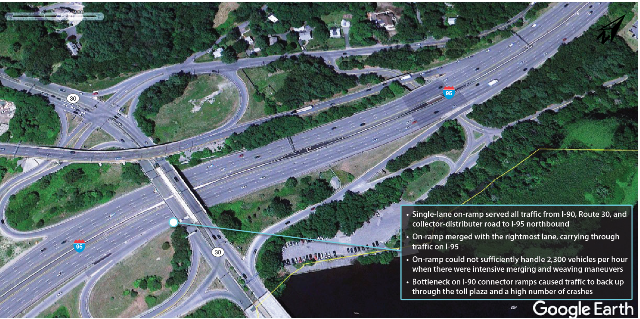
Recommendations
- Reallocating lanes on I-95 northbound to serve traffic demand better
- Creating a two-lane on-ramp for traffic from I-90, Route 30, and the collector-distributor road to merge onto I-95 northbound.
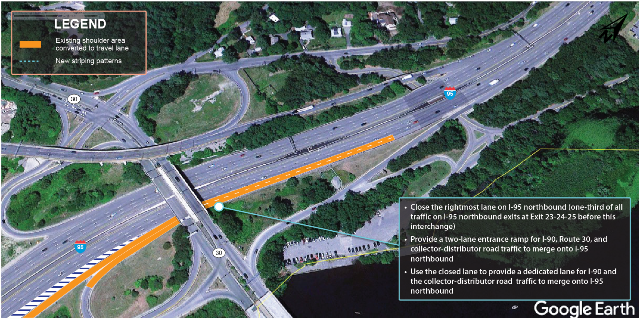
Status
- After a two-week demonstration project in July 2013, MassDOT formalized the implementation.[iv] Today MassDOT has closed the rightmost lane and provided a two-lane on-ramp.
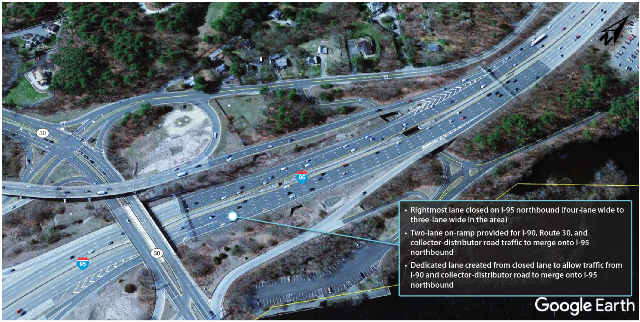
I-95 northbound exit and entry ramps at Route 3 and Middlesex Turnpike in Burlington
Existing Conditions
A high volume of traffic on I-95 northbound exits to Route 3 northbound and the Middlesex Turnpike during evening peak periods. Recurring congestion backs up traffic for several miles and affects the traffic operations of other interchanges. I-95 (Route 128) was constructed in the 1950s, so does not meet the stricter design standards in use today.
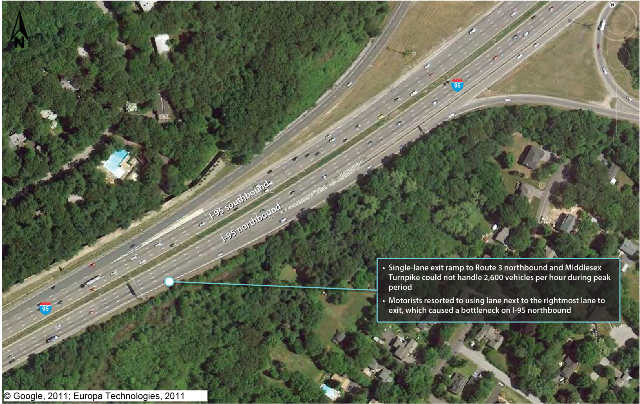
Recommendations
- Adding a fifth lane on I-95 northbound north of the Grove Street underpass and a two-lane exit ramp to connect to Route 3 and Middlesex Turnpike.
- Utilizing a section of the traffic-bearing right shoulder (approximately 1,000–1,500 feet) as an auxiliary lane for traffic entering I-95 northbound from Route 3 and Middlesex Turnpike.
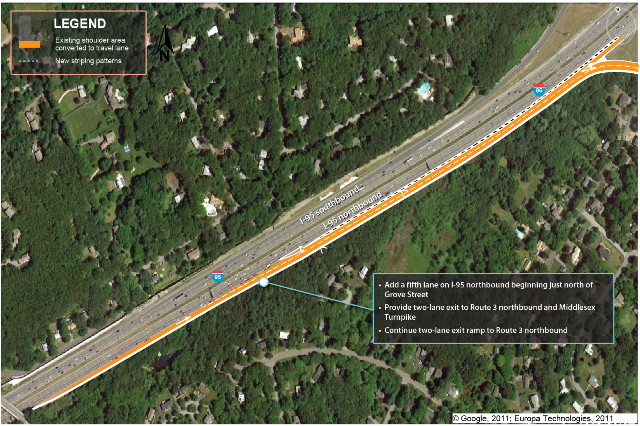
Status
- MassDOT implemented these solutions in 2017 as part of a resurfacing project, which has been functioning well.
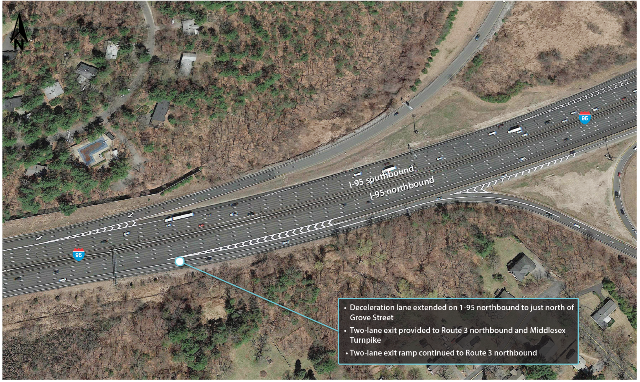
In 2012, the MPO expanded the scope of the study to look at interchanges of state highways, in addition to interstate highways.
I-95, between Interchange 28B in Waltham and Interchange 29A in Lexington
Existing Conditions
In the northbound section, I-95 carries heavy traffic during the evening peak period. The southbound section of I-95 is congested during the morning peak period, where the high volume of traffic entering from Route 2 eastbound causes further delays. Drivers engage in intensive diverging maneuvers, accompanied by lane changing, and decelerating and accelerating activities. In addition, the short deceleration lane (about 250 feet long) does not provide sufficient capacity in the diverging area.
Recommendations
- Extending the deceleration lane on I-95 southbound for a distance of approximately 600 feet plus the necessary taper length
- Relocating and/or installing guardrails and catch basins
- Relocating the DeCordova Museum exit sign and roadside traffic regulatory and guide signs
I-95 southbound, at the off-ramp area of Interchange 32B in Burlington
Existing Conditions
There is recurring congestion upstream of the bottleneck location during both morning and evening peak periods; the bottleneck backs up traffic and affects traffic operations at the adjacent upstream interchange (Interchange 33). The queues often approach Interchange 33 (about one mile away). The primary factor contributing to the formation of this bottleneck is the high volume of traffic on I-95 southbound that exits to the Middlesex Turnpike and Route 3 northbound during the peak periods. During 2006 to 2008, there were 146 crashes between the off-ramp and the on-ramp from Route 3 southbound.
Recommendations
- Constructing a new one-lane off-ramp farther upstream for about 600 feet, with a taper of about 150 feet
- Adding a second lane to the existing off-ramp for about 600 feet, connected by a taper to the new one-lane off-ramp
- Relocating and installing guardrails, catch basins, and overhead signs
- Installing new signs to direct motorists to Route 3 and the Middlesex Turnpike
Status
- Using maintenance funds, MassDOT has implemented recommendations at both locations with some modifications.
I-93 Southbound between I-95 and Montvale Avenue in Woburn and Stoneham
Existing Conditions
This section experiences intense interruption of traffic flow because of the merging and diverging maneuvers of high-volume traffic entering and exiting the freeway. There were 61 crashes in this area between 2010 and 2012. The majority (52 crashes) occurred in the vicinity of the short deceleration lane to Montvale Avenue. Thirty-four percent of the crashes resulted in injury, including one fatal injury.
Recommendations
- Creating an auxiliary lane for merging and diverging traffic
- Relocating existing guide signs or installing new signs, as well as pavement markings, to direct drivers to merge onto the mainline or diverge to exit onto Montvale Avenue
I-95 Southbound at the I-90 Interchange in Weston
Existing Conditions
There are two bottleneck locations on the I-95 southbound barrel at the I-90 Interchange in Weston. The existing bottlenecks, along with substandard acceleration and deceleration lanes, result in a long traffic queue on the I-90 connector during morning and evening peak periods. This queue affects I-90 traffic on the connector heading to I-95 northbound. There were 77 crashes in this section between 2010 and 2012. MPO staff believed that many of the rear-end and sideswipe crashes were caused by drivers slowing down to exit the freeway to I-90, or by drivers changing lanes.
Recommendations
- Designating an “Exit Only” lane at Exit 25
- Restriping the southbound lanes (to make three instead of four travel lanes) between Exit 25 and the entrance ramp from I-90 in order to serve traffic demand better
Status
- At the time of the 2015 study, MassDOT Highway District 6 had already undertaken the I-95/I-93 Transportation Improvement Project, which would remove a downstream bottleneck on I-95 southbound just north of Route 9 in Wellesley. The I-95/I-93 project is currently under construction and should be complete in spring 2019. At the time of the 2015 study, Asante noted that the proposed improvements at I-95 Southbound at the I-90 Interchange in Weston would benefit from the I-95/I-93 project, and stressed the importance of executing or planning the improvements. Today, MassDOT has in fact implemented the recommendations at this location, closing the rightmost lane on I-95 southbound, and providing an auxiliary lane for traffic from I-90 and Route 30 merging onto I-95 southbound.
I-95 Northbound Segment between Exit 29 (Route 2) and Exit 30 (Route 2A/Service Plaza) in Lexington
Existing Conditions
This bottleneck is present during both AM and PM peak periods. The I-95 northbound mainline can carry as many as 7,600 vehicles per hour; as many as 1,500 vehicles per hour merge from Route 2 westbound; and as many as 1,300 vehicles exit to Route 2A and the service plaza. The merging and diverging activities of these vehicles slows traffic on the freeway upstream of the Route 2A interchange, making it difficult to enter the freeway from Route 2. A high volume of traffic and a short acceleration lane at the ramp from Route 2 creates intense interruption of traffic flow primarily during PM peak travel periods. It reduces travel speeds on the freeway mainline to 35 mph or less during the PM peak period. There were 108 crashes in this area between 2010 and 2014. The majority (98 crashes) occurred in the vicinity of the off-ramp at Exit 30.
Recommendations
- Rerouting the entering and exiting traffic from the mainline travel lanes to an auxiliary lane using the traffic-bearing shoulder
- Adding new signage at Exit 30
I-93 Southbound Segment between Exit 37C (Commerce Way) and Exit 37B (I-95) in Woburn and Reading
Existing Conditions
During the morning peak period, traffic going to I-95 southbound backs up on the ramp and spills onto the I-93 mainline, impacting flow on the rightmost low-speed southbound lane. As a result, motorists attempt to get into the breakdown lane as soon as possible to stay clear of the low-speed lane. A high volume of traffic using Exit 37B to I-95 southbound during the morning peak period and insufficient queueing space for the Exit 37B ramp interrupts traffic flow and creates a safety hazard. There were 47 crashes in this section between 2010 and 2014. The majority, 43 of the crashes, occurred in the vicinity of the diverge area at Exit 37B. Twenty-eight percent of the crashes resulted in injury.
Recommendations
- Creating an auxiliary lane for merging and diverging traffic at Exit 37B
- Lengthening the acceleration lane at the merge from Commerce Way on I-95 southbound
Status
- Because of chronic problems, MassDOT has a long-range plan for the I-93/I-95 interchange. Asante notes that the potential major investment planned at this interchange should be taken into account when deciding on short-term solutions.
Route 24 Northbound Segment between Exit 20 (Route 139) and Exit 21 (I-93) in Randolph, Canton, and Stoughton
Existing Conditions
Bottleneck conditions emerge primarily during the morning peak period and extend south from I-93 in Randolph as far as Route 27 in Brockton, approximately seven miles. The merging activity of vehicles on I-93 slows traffic on the Route 24 connector ramps and causes traffic to back up on Route 24. A high volume of traffic using Exit 21 to I-93, a short diverge length where the two ramps split at the I-93 interchange, the forced merge to a single lane on the I-93 southbound ramp, and a short merge length at the I-93 northbound ramp create this bottleneck. There were 96 crashes in this area between 2010 and 2014. The majority (63 crashes) occurred leading up to the diverge at the I-93 interchange. Thirty-five percent of the crashes resulted in injury, including one fatal.
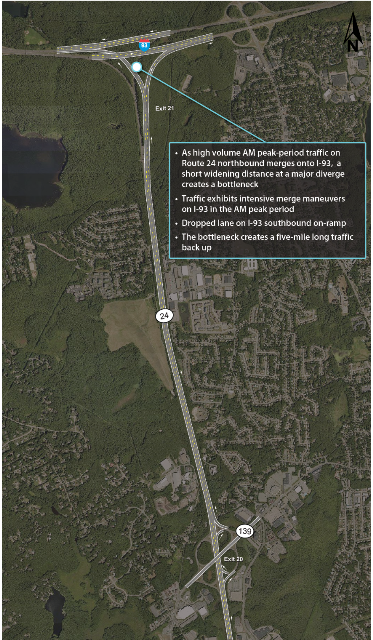
Recommendations
- Widening Route 24 northbound to four lanes
- Continuing the extra lane south until the Canton Street bridge
- Removing the merge on the ramp to I-93 southbound
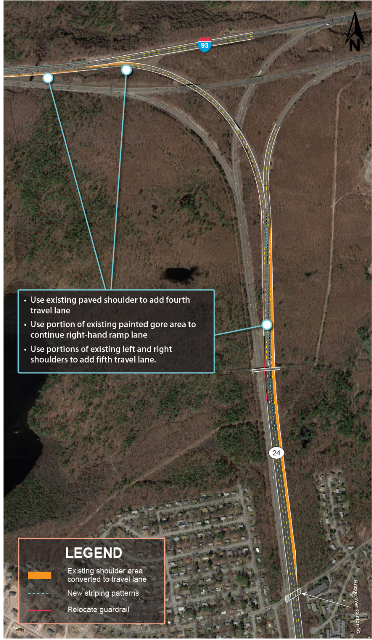
Route 24 Southbound Segment between Exit 21 (I-93) and Exit 20 (Route 139) in Randolph, Canton, and Stoughton
Existing Conditions
During the evening peak period, a high volume of traffic using I-93 Exit 4 to Route 24 and suboptimal merge geometry at the start of Route 24 southbound creates a bottleneck that causes a mile-long traffic queue from the Canton Street Bridge under Route 24 onto I-93 northbound and southbound. There were 238 crashes in this area between 2010 and 2014. Twenty-seven percent of the crashes resulted in injury, including one fatal.
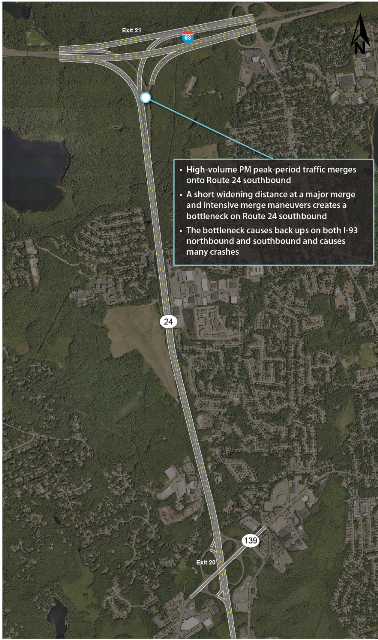
Recommendations
- Lengthening the merge distance at the ramp junction
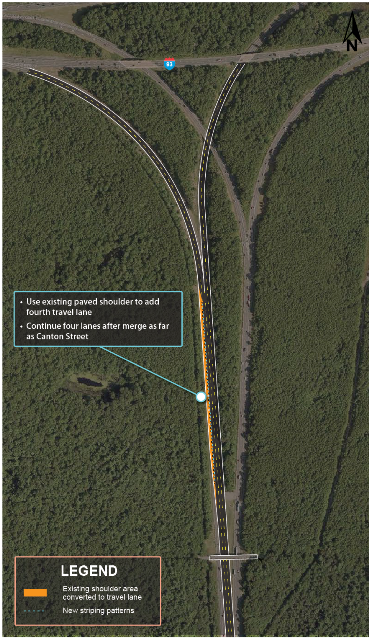
Status
- Asante reports that MassDOT Highway District 6 is currently reviewing all the recommendations for Route 24 northbound and southbound to address the AM peak period congestion that extends all the way from Canton to Brockton.
[i] https://ops.fhwa.dot.gov/publications/fhwahop18013/chap1.htm
[ii] See endnote i.
[iii] https://ops.fhwa.dot.gov/bn/index.htm
[iv] http://blog.mass.gov/transportation/massdot-highway/weston-i-90i-95-new…
